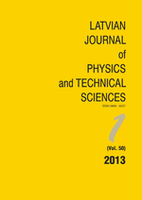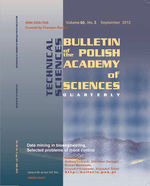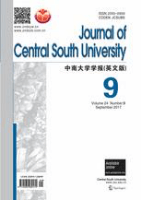
Latvian Journal of Physics and Technical Sciences
Scope & Guideline
Empowering Scientific Dialogue for a Technological Future
Introduction
Aims and Scopes
- Applied Physics and Engineering:
The journal emphasizes practical applications of physics in engineering, including studies on materials science, energy systems, and technological innovations. - Sustainable Energy Solutions:
A significant focus is placed on sustainable energy technologies, including renewable energy sources, energy efficiency, and the development of smart energy systems. - Materials Science and Nanotechnology:
Research on advanced materials, nanostructures, and their applications in various fields, such as electronics and environmental technology, is a core area. - Environmental and Earth Sciences:
The journal publishes research related to environmental physics and earth sciences, including studies on climate change, pollution, and resource management. - Computational Modelling and Simulation:
There is a strong emphasis on computational methods for modeling complex systems, including fluid dynamics, energy systems, and structural analysis. - Interdisciplinary Research:
The journal encourages interdisciplinary studies that combine physics with other scientific domains, such as chemistry, biology, and environmental science.
Trending and Emerging
- Renewable Energy Technologies:
There is a significant increase in research related to solar, wind, and other renewable energy technologies, reflecting a global push towards sustainable energy solutions. - Smart Grid and Energy Management Systems:
Emerging topics include smart grid technologies and energy management systems, emphasizing efficiency and integration of renewable energy sources. - Advanced Nanomaterials and Their Applications:
Research focused on the synthesis and application of advanced nanomaterials is on the rise, particularly in electronics, energy storage, and catalysis. - Energy Communities and Decentralized Energy Systems:
Investigation into energy communities and decentralized systems is gaining traction, highlighting the role of local energy solutions in sustainability. - Environmental Monitoring and Climate Change Mitigation:
Research addressing climate change through innovative monitoring techniques and mitigation strategies is increasingly prevalent. - Artificial Intelligence in Engineering Applications:
The integration of artificial intelligence and machine learning in engineering and physics research is emerging as a key trend, enhancing predictive modeling and system optimization.
Declining or Waning
- Conventional Energy Systems:
Research on traditional energy systems, such as fossil fuels, has seen a decline as the focus shifts towards renewable energy and sustainable technologies. - Basic Theoretical Physics:
There seems to be a waning interest in purely theoretical physics papers that do not have immediate practical applications, as the journal favors applied research. - Materials Characterization Techniques:
Although materials science remains a focus, specific traditional characterization techniques are being overshadowed by advancements in nanotechnology and novel materials. - Industrial Applications of Traditional Materials:
Studies focused on conventional industrial applications of materials, such as metals and plastics, are less frequent, likely due to a shift towards more innovative materials. - Basic Photonics Research:
Research centered on fundamental photonics without a clear application or technological advancement appears to be declining in the journal's publications.
Similar Journals

DOKLADY PHYSICS
Shaping the Future of Physics Research and Application.DOKLADY PHYSICS is a prominent academic journal dedicated to advancing knowledge in the fields of computational mechanics, mechanics of materials, and general physics and astronomy. Published by MAIK NAUKA/INTERPERIODICA/SPRINGER, this journal has established itself as a crucial resource for researchers and professionals keen on exploring the intricacies of physical phenomena and engineering applications. With its ISSN 1028-3358 and E-ISSN 1562-6903, DOKLADY PHYSICS has been contributing to scientific discourse since its inception in 1996 and continues to provide a platform for innovative research up to 2023. Despite its current Q3 ranking in several key categories, the journal maintains an inclusive approach, striving to influence both academic and practical aspects of its fields. While the journal may not be open access, it remains a vital publication for those interested in high-quality research, as reflected in its Scopus ranking positions across various engineering and physics categories.

REVISTA MEXICANA DE FISICA
Empowering Scientific Discourse in Physics and AstronomyREVISTA MEXICANA DE FISICA is a prominent academic journal dedicated to advancing knowledge in the fields of Physics and Education. Published by the SOC MEXICANA FISICA, this journal plays a pivotal role in disseminating innovative research and educational methodologies from Mexico and beyond. With a publication history that spans from 1991 to 2024, it has established itself as an essential resource for researchers, professionals, and students who seek to deepen their understanding of general physics and astronomy. The journal is classified in the Q3 quartile in both education and physics & astronomy, showcasing its quality and relevance within the academic landscape. While the journal currently operates on a subscription basis, it provides a valuable platform for emerging voices and established scholars alike. By fostering a collaborative environment for scientific discourse, REVISTA MEXICANA DE FISICA continues to be an important channel for the ongoing evolution of scientific education and exploration in the physical sciences.

Bulletin of the Polish Academy of Sciences-Technical Sciences
Unveiling Breakthroughs in Engineering and BeyondBulletin of the Polish Academy of Sciences-Technical Sciences is a distinguished peer-reviewed journal published by the Polish Academy of Sciences, focusing on a broad spectrum of disciplines within technical sciences. With an E-ISSN of 2300-1917 and an established presence since 1983, this journal transitioned to an Open Access model in 2009, ensuring wide dissemination of innovative research findings. Recognized for its contributions, the journal boasts notable rankings in various categories, including Q4 in Artificial Intelligence and Q3 in fields such as Computer Networks and Communications and Atomic and Molecular Physics, as indicated by its Scopus rankings. With its strategic location in Warsaw, Poland, and a commitment to advancing knowledge and technology, the Bulletin serves as a vital platform for researchers, professionals, and students to share and engage with cutting-edge developments in engineering and related fields. Emphasizing high-quality research, this journal offers an essential resource for anyone looking to enhance their understanding of current trends and breakthroughs in technical sciences.

Transactions of the Korean Society of Mechanical Engineers B
Pioneering insights for the future of mechanical technologies.Welcome to the Transactions of the Korean Society of Mechanical Engineers B, a pivotal journal dedicated to advancing the field of mechanical engineering. Published by the esteemed Korean Society of Mechanical Engineers, this journal serves as a platform for the dissemination of innovative research and practical applications in mechanical engineering and related disciplines. With a focus on fostering knowledge exchange and collaboration, the journal publishes original research articles, reviews, and technical notes that contribute to the understanding and evolution of mechanical systems and technologies. The Transactions of the Korean Society of Mechanical Engineers B, which has been in circulation since 2007 and spans through 2024, is categorized within the Q4 quartile of mechanical engineering rankings and is indexed by Scopus, making it a valuable resource for researchers and professionals aiming to stay abreast of the latest developments in the field. Although it is not open access, its rigorous peer-review process ensures the integrity and quality of the published work, making it essential reading for academics and practitioners alike.

National Science Review
Fostering groundbreaking research for a sustainable future.National Science Review, published by Oxford University Press, stands as a premier open-access journal dedicated to advancing the frontiers of multidisciplinary scientific research. With an impressive impact factor reflective of its high citation rates and a Q1 ranking within its category as of 2023, it ranks #5 out of 171 journals in its field, placing it in the 97th percentile of Scopus' multidisciplinary rankings. Since its inception in 2014, the journal has evolved into a pivotal platform for the dissemination of innovative findings across various scientific disciplines, attracting contributions from leading researchers globally. Accessible to both academics and professionals alike since its transition to open access in 2020, the journal not only promotes collaboration but also ensures the broad dissemination of knowledge critical for tackling pressing global challenges. Residing in the historic city of Oxford, United Kingdom, it continually seeks to contribute to the global conversation on scientific advancements and their implications for society, making it an indispensable resource for anyone at the intersection of science and innovation.

Computational Thermal Sciences
Fostering Collaboration in Cutting-edge Thermal ResearchComputational Thermal Sciences, an esteemed journal published by BEGELL HOUSE INC, presents cutting-edge research at the intersection of computational mathematics, energy engineering, and fluid dynamics. With an ISSN of 1940-2503 and an E-ISSN of 1940-2554, this journal aims to disseminate high-quality research articles, reviews, and methodologies that improve our understanding of thermal processes and their applications. Renowned for its solid impact in the field, it holds a Q3 ranking in multiple categories including Computational Mathematics and Energy Engineering for 2023. As the field evolves, the journal continues to play a pivotal role in bridging theoretical research with practical innovations, thereby catering to a diverse audience of researchers, professionals, and students. Although it operates on a subscription model, the journal ensures accessibility to significant contributions in thermal sciences from 2009 to 2024, fostering an environment of knowledge sharing and collaboration.

Proceedings of the Romanian Academy Series A-Mathematics Physics Technical Sciences Information Science
Bridging Disciplines: Where Mathematics Meets EngineeringProceedings of the Romanian Academy Series A-Mathematics Physics Technical Sciences Information Science, published by EDITURA ACAD ROMANE, is a noteworthy academic journal that serves as a platform for disseminating original research in the intersecting fields of mathematics, physics, engineering, and computer science. With an ISSN of 1454-9069, this journal not only highlights the vibrant academic contributions from Romania but also attracts international submissions, thus fostering global collaboration. Though it currently does not offer an open-access model, the journal remains indexed in significant databases, reflecting its commitment to quality and scholarly rigor. The journal’s impact can be seen through its rankings, including Q4 in Computer Science, Q3 in Engineering, and Q4 across Mathematics and Physics, as well as its Scopus percentile rankings, which indicate meaningful contributions to these domains. With a converged publication span from 2008 to 2024, it aims to catalyze advancements in technical sciences while enriching the academic discourse among researchers, professionals, and students alike. The journal’s headquarters in Bucharest, Romania, positions it as a key player in the Eastern European academic landscape, making it essential reading for those engaged in cutting-edge research.

Journal of Central South University
Unveiling Breakthroughs in Materials ScienceThe Journal of Central South University, with ISSN 2095-2899 and E-ISSN 2227-5223, stands as a leading publication in the fields of Engineering and Materials Science, particularly in Metals and Alloys. Published by JOURNAL OF CENTRAL SOUTH UNIV, this journal has established itself as a vital source of innovative research and technical advancements, emphasizing interdisciplinary approaches and practical applications. With an impressive Q1 ranking in both Engineering (miscellaneous) and Metals and Alloys for 2023, it is recognized for its high-impact contributions, reflected in its rankings of Rank #52/307 in General Engineering and Rank #35/176 in Metals and Alloys within Scopus. The journal aims to disseminate cutting-edge research findings and insightful discussions, making it an essential resource for researchers, professionals, and students keen on advancing their knowledge in these dynamic fields. Although it is not open access, the journal's reach and reputation ensure that its contents are accessible to a broad academic audience interested in the significant developments shaping the future of engineering and materials science.

AIP Advances
Pioneering Discoveries in Science and Technology.AIP Advances, published by AIP Publishing in the United States, is an esteemed open-access journal that has been pivotal in disseminating knowledge in the fields of Nanoscience and Nanotechnology and Physics and Astronomy since its inception in 2011. With an unwavering commitment to enhancing global scientific communication, the journal provides a platform for groundbreaking research and innovative methodologies, catering to a diverse audience of researchers, practitioners, and students. As of 2023, AIP Advances enjoys a respectable impact factor that reflects its significance in the academic community, ranking in the Q3 category for both Nanoscience and Nanotechnology and Physics and Astronomy. The journal has made its contributions accessible, reinforcing its mission of promoting collaboration and knowledge sharing across disciplines. Researchers interested in publishing their work will find AIP Advances not only a valuable medium for their findings but also a hub for the latest advancements and discussions shaping these dynamic fields.

JOURNAL OF ENGINEERING PHYSICS AND THERMOPHYSICS
Exploring Innovative Solutions in Thermal and Physical EngineeringJOURNAL OF ENGINEERING PHYSICS AND THERMOPHYSICS, published by Springer, is a vital resource for researchers and professionals in the fields of engineering physics and thermophysics. With an ISSN of 1062-0125 and an E-ISSN of 1573-871X, this esteemed journal has been disseminating high-quality research since its inception, covering critical advancements in both condensed matter physics and various engineering disciplines. Despite its classification within the third quartile in both Scopus categories for 2023, the journal remains a significant conduit for innovative studies that push the boundaries of knowledge in thermal and physical engineering, with converged years spanning from 1992 to 1997 and 2004 to 2024. The journal does not offer open access, which means subscribers and institutions have exclusive access to its rich content. As the field continues to evolve, JOURNAL OF ENGINEERING PHYSICS AND THERMOPHYSICS plays an essential role in fostering scholarly discussions and supporting the academic community in tackling contemporary engineering challenges.